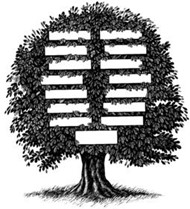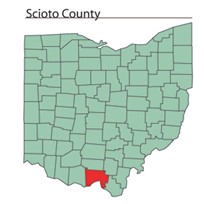Archive for the ‘Sherman’ Category
Combing the Indiana Records
 The hunt for information about my 2nd great-grandmother, Katherine Stillenbaugh, continues. To make any progress I must follow a disciplined research plan.
The hunt for information about my 2nd great-grandmother, Katherine Stillenbaugh, continues. To make any progress I must follow a disciplined research plan.
I start with the only fact I know about her. She lived in Indiana in 1865. There she bore a daughter, my great-grandmother Anna Petronellia Sherman, in April of that year. The family always reported that Anna Petronellia was born at Indianapolis and Katherine died there, but Anna P.’s 1885 Kansas census record gives her birthplace as Edinburg, Indiana. This town lies 20-30 miles south of Indianapolis in Johnson County near the intersection of three counties—Bartholomew, Johnson, and Shelby.
With Indiana as a starting point, I began my research by identifying what Indiana records might exist and where they might be housed. During a visit to the Denver Public Library a couple of weeks ago, I consulted the National Genealogical Society’s Research in The States guide for Indiana. It provides many research options.
I decided to begin with online offerings at the major state repositories. These include the following:
- Allen County Public Library,
- Indiana Historical Society,
- Indiana State Archives,
- Indiana State Library,
- Several academic libraries.
Over the last two weeks I began visiting the websites for these institutions. I found little useful information on the Allen County site, and I learned that the Indiana Historical Society has no online databases.
The Indiana State Archives offers a digital archive. There I found some military records and commitment papers for the Stilgenbauer family but nothing for the Shermans. I continue to work under the hypothesis that because of the similarity of names, the Stilgenbauers might be my Katherine’s family, so I collected their information. Unfortunately, nothing here offered any evidence of a connection to my ancestor.
The Indiana State Library has several digitized genealogical resources, and I looked first at Bartholomew County, for no other reason than it is first alphabetically on the list of the three counties of interest. The library holdings included county histories from 1888 and 1904—long after my ancestor died and her daughter had moved on to Illinois and beyond. Neither volume mentioned the Sherman family at all nor did they contain any relevant information about the Stilgenbauer family. The third book was The People’s Guide, an 1874 county directory that serves as a census substitute in the absence of a state census.
The People’s Guide tells me that Nicholas Stillabower, born in 1823 in Germany, lived seven miles west of Taylorsville (about 5 miles south of Edinburg). He had settled there in 1851. He was a Democrat and a Lutheran. From earlier research, I know that Nicholas did have a daughter Catherine who was born in 1847, the right age to be my Katherine. Unfortunately, this Catherine married someone named Long and lived until 1883. The only way she could be my ancestor is if the story of Katherine’s death in childbirth is wrong. Instead, the death story would have been concocted after she and the baby’s father had separated. Before going down this road in my research, I plan to continue the search for my Katherine elsewhere. Still, it is a possibility to keep in mind.
My next step will be to continue my research at the Indiana State Library by moving on to Johnson County. This takes a tremendous amount of time, but I must search every source available. Doing it from home certainly takes much less time and money than making a trip to Indiana to do it. I may need to go there eventually, but much remains for me to do from Colorado first.
An Expanded Search
 Despite some diligent research, my attempt to identify my German 2nd great-grandmother, Katherine Stillenbaugh, has gone nowhere this week. I need to broaden the search.
Despite some diligent research, my attempt to identify my German 2nd great-grandmother, Katherine Stillenbaugh, has gone nowhere this week. I need to broaden the search.
Family lore tells me that this woman immigrated at the age of 8, gave birth to my great-grandmother, Anna Petronellia Sherman, at Indianapolis in 1865, and died shortly thereafter. I have not found a marriage record for her. With no birth and death records kept that early in Indiana, I must use other means to pinpoint this little family of Thomas, Katherine, and Anna P. Sherman. An Indiana census record would have been nice.
As far as I know, Indiana did not conduct a census in 1865 so I am out of luck for that year. Because Katherine had died by the time of the 1870 U. S. census, her name would not appear there. Indeed, by 1870 little Anna Petronellia lived with her paternal grandmother, Rebecca Sherman, in Illinois.
That leaves me looking back before the Civil War to the 1860 U. S. census. Did Katherine live in Indiana in 1860? No family named Stillenbaugh lived there, or anywhere else, for that matter. Stillenbaugh must be a corruption of her family’s true German name.
I discovered a clue to what it might have been by following the movements of the husband, Thomas Sherman. In 1860, he was a single man living in his parents’ household in Kentucky, not Indiana. However, his older brother Anderson did live in Indiana by then, in Hamblen Township, Brown County, just south of Indianapolis. And Anderson was surrounded by German neighbors named Stillabower.
Were these my Katherine’s people? None of the six families had a daughter Katherine/Catharine in 1860 although Michael P. had an 8-year-old Mary C. Family information found on FindAGrave.com tells me that these families, all related, included three immigrant brothers, Jacob, Adam, and Michael, and three of their sons, Michael C., Michael P., and John. The FindAGrave site also tells me that the Stillabower family had many more members than just these. In fact, the original German name was Stilgenbauer, and they were Lutherans from Bavaria. Some settled first in Ohio and later moved on to Indiana.
Looking beyond the 1860 census, I know that by 1863, Anderson Sherman had moved out of Brown County and into neighboring Johnson County, also just south of Indianapolis. Thomas lived there, too. Another younger Jacob Stillgenbauer lived nearby. Unfortunately, in 1860 he did not have a daughter named Katherine/Catherine either, but he did have a 10-year-old girl named Caroline. Caroline? Catharine? It is a possibility, but she would have been just 15 in 1865. I cannot presume that she was my girl. Still, her later whereabouts are worth a look.
And that is where my search ended this week.
Armed with the information uncovered so far, I plan to do some more investigation of this German Stilgenbauer family, both elsewhere in Indiana and in other states where family members may have resided before landing in Indiana. The Civil War disrupted people’s lives, and folks moved around during those years. My Katherine could have lived anywhere in 1860.
I also hope to learn whether any Lutheran church records for the 1860’s Indianapolis area survive. I have found no county marriage record for Thomas and Katherine in Indiana. If the Stilgenbauers were Lutheran, perhaps this couple married in the Lutheran church even though Thomas probably was not Lutheran himself. He did not seem averse to a church wedding because a Methodist minister officiated at his second marriage to Mary Scott in 1872.
My other research possibility is to look for Stilgenbauers on the 1850 U.S. census. The difficulty with this is that I do not know what year Katherine was born or what year she immigrated. A young woman married to a 23-year-old man (Thomas) by 1865 was likely born in the 1840’s. My family says Katherine left Germany at the age of eight, so perhaps she was in America by 1850. From the FindAGrave information I cannot tell with any precision when the Brown County Stillabowers immigrated. The older Adam was said to have come over in 1836, while Jacob’s son Adam was born in Germany in 1838. If this was my family, other relatives, including mine, may have followed in the 1840’s and 1850’s.
This leaves me with so many people to sort through. The time-consuming search for my Katherine continues. Stay tuned.
A Step-By-Step Plan for Finding Katherine
 I am on the hunt for any information available on my 2nd great-grandmother. So far I have turned up almost nothing, but I am not discouraged yet. I am pursuing a research plan, step-by-step.
I am on the hunt for any information available on my 2nd great-grandmother. So far I have turned up almost nothing, but I am not discouraged yet. I am pursuing a research plan, step-by-step.
The search began at home with tales of family lore. My dad’s cousins and aunts told me that the elusive woman’s name was Katherine Stillenbaugh/Stanabaugh, and she immigrated from Germany when she was eight years old. She died at Indianapolis shortly after giving birth to my great-grandmother, Anna Petronellia Sherman, in 1865.
I have done an exhaustive search on Katherine’s reported husband, my second great-grandfather Thomas Sherman. I have had no luck connecting him to this alleged first wife or her family. He did live south of Indianapolis during the Civil War, so at least that much of the story matches.
Armed with these bits of information, I began my search for Katherine in earnest earlier this month. My steps:
- Thomas Sherman and his brother actually resided in Johnson County, Indiana, not Indianapolis, so I looked at the county histories for that location. I found no mention of the Sherman family or any German family with a name similar to the one I seek. I did not find an Indiana marriage record for my Thomas Sherman in the 1860’s.
- A search of the 1860 U.S. census for Johnson and surrounding counties turned up an extended German family named Stilgenbauer or Stillabower. This family name sounds promising, and I decided to do some research on them to find out whether anyone had a likely daughter named Katherine.
- On FindAGrave.com, I found memorials for many members of this Stilgenbauer family. Each contained links to the others. This family descends from three brothers (Jacob, Adam, and Johan Michael) who immigrated from Bavaria—a German state. Interestingly, these southern Germans seemed to be Lutheran, not Catholic. This information fits, too, because Thomas Sherman was Protestant, not Catholic, and it is unlikely he would have married into a Catholic family. Thank you to Mike E. Wirey who created all these memorials in 2007.
- I spent a considerable amount of time this week reviewing Wirey’s information and reconstructing the Stilgenbauer family relationships on a white board. Catherine seems to be a common name with them, but I did not spot a girl who fit the profile of my Katherine. They all either died quite young or had married names other than Sherman.
Still more digging remains to be done. The FindAGrave information is not a complete family tree. What will I do next?
- I can try to contact Mike E. Wirey to find out if he has any additional Stilgenbauer information, particularly on girls named Katherine.
- I can look at the 1860 U.S. census for Johnson and all the surrounding counties for more members of the Stilgenbauer family to see if I can find another Catherine who seems a better match for my ancestor.
- I can take a DNA test to find out if I am match for any Stilgenbauers or their descendants who might have taken a test.
- I know where Thomas Sherman lived in 1863, and I can reconstruct his neighborhood, looking for clues.
- I can work to identify pertinent records at the Johnson County Museum, the Johnson County Historical Society, and other repositories. Did Thomas Sherman associate with the Stilgenbauers, or did the families have associates in common? Thomas had a German sister-in-law named Mishler, so I know his family associated to some extent with their German neighbors.
This search promises to take a long time. I probably will never find a single piece of paper proving the identity of my ancestor. But I can pursue my research plan in the hopes of identifying a likely candidate and then building enough circumstantial evidence to prove a case.
Finishing Up for 2016
 I am closing out another research year. For the last twelve months I have researched the life of my blacksmith great-great grandfather, Thomas Sherman. I have learned about his life and written up my findings for distribution to my family. For wider dissemination of the information I have gathered, I have put all the names, dates, and places into the family tree on Family Search (www.familysearch.org).
I am closing out another research year. For the last twelve months I have researched the life of my blacksmith great-great grandfather, Thomas Sherman. I have learned about his life and written up my findings for distribution to my family. For wider dissemination of the information I have gathered, I have put all the names, dates, and places into the family tree on Family Search (www.familysearch.org).
During the year I learned that Thomas, like many in the nineteenth century, moved around a bit, as evidenced by these life events:
- Born 23 November 1841 in Ohio,
- Grew to manhood in Kentucky, and learned the blacksmith trade from his father, Daniel Sherman,
- Married his first wife, fathered his first child, and registered for the Civil War draft in Johnson County, Indiana,
- Married twice more and fathered five more children in eastern Illinois,
- Died 3 February 1912 at Charleston, Illinois.
A big mystery still not answered from my research this year is the identity of his first wife. Next year I plan to continue with the Sherman research in an effort to discover who she may have been. I do have a name and place to go on—Katherine Stillenbaugh/Stanabaugh of Indianapolis, Indiana. Family lore says she immigrated from Germany.
I would just love to place this woman, my great-great grandmother, into her birth family. I plan a trip to Germany in 2017, and it would be wonderful to know more about her by then.
Planning a Project for 2017
 The life of our ancestor Katherine Stanabaugh remains a mystery to me and my family. We know so little about her, and we have found next to nothing of her life in any records.
The life of our ancestor Katherine Stanabaugh remains a mystery to me and my family. We know so little about her, and we have found next to nothing of her life in any records.
Most of our information comes from family lore:
- Katherine immigrated from Germany when she was eight years old.
- Katherine married the blacksmith, Thomas Sherman, during the Civil War.
- Katherine’s only child, Anna Petronellia Sherman, was born at Indianapolis on 1 April 1865.
- Katherine passed away shortly after her daughter’s birth.
- Katherine was buried at Indianapolis.
- Katherine’s surname appears as Stillenbaugh in family papers, and as Stanabaugh on her daughter’s 1961 death certificate (a record created nearly a century after Katherine herself had died, by a grandson who never knew her).
I have been unable to corroborate any of this information. I cannot locate any Stillenbaugh or Stanabaugh families in 1860’s Indiana. I cannot locate a marriage record for Thomas and Katherine. I cannot locate a death record or grave for Katherine.
This weekend I attended a Palatines to America seminar where the special guest was Kent Robinson, the President of the organization. He resides in Indiana and kindly offered to look at this case. I am hoping he can offer some advice on records I have not thought to search.
Beyond that, my best course of action will be to create a research project using the FAN approach to genealogy. This acronym stands for the groups of people one must research (Friends, Associates, Neighbors) when the subject leaves little or no paper trail. A look into the lives of these people can often reveal details of the life of an ancestor. Circumstantial evidence gleaned from their records can help a genealogist build a case for placing the ancestor into the proper family.
Katherine will be my research project for 2017. She deserves more than a passing mention in our family history.
52 Ancestors in 52 Weeks no. 36—Rebecca Howe Day (1808-1876)
 A search for the Day family in central Kentucky during the 1800’s reveals a large extended family, difficult to sort. My 3rd great-grandmother Rebecca was born into this clan on the 5th of June, 1808. She was named for her maternal grandmother, Rebecca Howe. Her parents were Daniel Day and Rhoda Hoskins. Young Rebecca actually was born in Tennessee, but the family soon moved on to Kentucky.
A search for the Day family in central Kentucky during the 1800’s reveals a large extended family, difficult to sort. My 3rd great-grandmother Rebecca was born into this clan on the 5th of June, 1808. She was named for her maternal grandmother, Rebecca Howe. Her parents were Daniel Day and Rhoda Hoskins. Young Rebecca actually was born in Tennessee, but the family soon moved on to Kentucky.
Rebecca’s father died when she was young, and she became the ward of her grandfather, John Day, a Revolutionary War veteran from Virginia. The family had settled in Morgan County when they reached Kentucky. There, Rebecca met a blacksmith, Daniel Sherman, and they decided to marry. The marriage took place on September 4, 1826 when Rebecca was eighteen years old.
Over the next years, Rebecca and Daniel traveled around central Kentucky and southern Ohio, wherever Daniel found work. Together they raised a large family of about ten children. By the time the Civil War broke out, they resided in Madison County, Kentucky.
At some point as the war progressed, they made the decision to move north. On April 29, 1863, they sold their small holding in Madison County. After that, Daniel disappears from the record. They may have relocated to Johnson County, Indiana where their eldest son, Anderson Sherman, lived.
By 1870, Rebecca, by then a widow, had moved again, following some of her children to Edgar County, Illinois. That year her household included her third son, John, and a granddaughter Anna Petronellia, the daughter of Rebecca’s second son, Thomas. Other Sherman children (Thomas Sherman, Evaline Sherman Alvey, and Jasper Sherman) lived in the same county.
Rebecca died in Edgar County on September 28, 1876. She was buried in the Swango Cemetery in Symmes Township although her grave is unmarked.
Much research remains to do on Rebecca and her birth family. Sources conflict on when and where her father died. Some family members claim her mother lived to be over 100 years old, although we have no proof of that. Some researchers claim Rebecca descended from the illustrious Howe family of Revolutionary War fame with connections to the English royal family.
Rebecca Howe Day will make a fascinating research subject when time permits.
The Glover Boys: Bad Men
 Genealogist like to talk about their Black Sheep ancestors. This week I found a few as I read some historic newspapers.
Genealogist like to talk about their Black Sheep ancestors. This week I found a few as I read some historic newspapers.
Members of my family became original pioneers of Coles County, Illinois around 1830. The locals kept good records, and I have quite a bit of success learning about the lives of those who lived in that area during the nineteenth century. The newspapers from Mattoon, Illinois provide an especially rich source. There I found many mentions of “Bad Man” Frank Glover and his siblings.
My second great-grandfather Thomas Sherman’s sister had married a Glover, and this is my connection to the Glover family. Frank was one of her sons. He and some of his brothers often ran afoul of the law. The Mattoon newspapers documented it all. They labeled Frank with the epithet, “Bad Man”.
What did he and his brothers do?
According to the papers, Frank had no occupation. Over a fifteen-year period, he robbed a man at gunpoint, shot a Sheriff’s deputy who attempted to repossess some property, and stabbed the village Marshal during a fight. He served time for these crimes.
Frank’s brother Henry Glover was a counterfeiter. The paper described Henry as a Republican who favored the unlimited coinage of silver and home-made dollars. Henry liked physical fights and even faced charges once for beating up Frank’s wife. Henry died a violent death when he mysteriously was shot in his home one Saturday night. He made a dying declaration naming his assailant, but no one believed him.
Another brother, Edward, ran a grocery story. He was indicted on occasion for selling tobacco to minors. His store seemed to suffer no end of criminal activity including burglary, robbery, and mysterious fires.
These guys definitely qualify as the Black Sheep of my family. Their cousin, my great-grandmother Anna Petronellia Sherman, was said to dislike her family. Perhaps these fellow’s activities contributed to her opinion. A staunch Methodist, Petronellia most certainly would have considered her Glover relatives to be bad men.
52 Ancestors in 52 Weeks no. 35—Daniel Sherman (abt. 1800-?)
 As we work further back in time, the details on our ancestors’ lives become murkier. Eventually, we find little or no information about them.
As we work further back in time, the details on our ancestors’ lives become murkier. Eventually, we find little or no information about them.
For many years now, one of my 3rd great-grandfathers, Daniel Sherman, has been what genealogists call a “brick wall” ancestor. He seemingly appeared out of nowhere, raised a large family, and then disappeared again. I know nothing about his birth family.
According to U.S. census records for Kentucky in 1850 and 1860, Daniel originally came from New York. He was born around 1800. He worked as a blacksmith, but he also had some education. In the 1850’s he wrote out permission slips for his daughters to marry.
Daniel began appearing in the Kentucky records in the late 1820’s. He married Rebecca Howe Day on September 4, 1826 in Morgan County. The next year, his name came up a couple of times in the Morgan County court minutes. The first time, he was appointed to take his turn to keep the state road in good repair. The second time, he was ordered to pay 37 ½ cents to a member of his wife’s family in a case involving horse feed. In 1828, he received payment of $2 when he resigned as county jailor.
That same year, Daniel and Rebecca started their family. They had at least ten children:
- Polly Ann, born about 1828
- Unknown daughter, born about 1829
- Anderson O., born 22 Aug. 1832
- Evaline, born 5 Aug. 1834
- Emily Elizabeth, born about 1836
- Eliza/Louisa Jane, born about 1838
- Thomas, my 2nd great-grandfather, born 23 Nov. 1841
- Gilla Ann, born 26 Mar. 1843
- John, born Dec. 1845
- Jasper, born 30 Oct 1849
During these years, Daniel and his wife moved around a lot. Their children were born in various Kentucky counties (Morgan, Bath, Clark, Madison, Estill) as well as in Scioto County, Ohio. The couple never seemed to own much land. Apparently, they followed the work he could get.
By 1853, Daniel finally appeared more ready to settle down in one place. On September 25 that year, he gave permission for his teenage daughter Eliza/Louisa to marry in Madison County. Several years later, on 4 January 1858, he purchased an acre of land on Clear Creek in the same county. Perhaps they intended to remain there with grown children nearby.
Then, during the course of the Civil War, for some reason Daniel and Rebecca changed their minds and decided to leave Madison County. They sold their land on 29 April 1863.
After that, Daniel disappears from the records. By 1870, Rebecca lived with relatives in Edgar County, Illinois. Daniel’s name has not been found on the 1870 census, so he probably died before then.
Before he died, Daniel passed some of his learning on to his sons. All of them picked up the blacksmith trade. That is how the family continued to earn its living into the next generation, well into the twentieth century.
So, who were Daniel’s people? When did his Sherman family come to America? Where did he end his days? The answers to these questions about the life of Daniel Sherman await discovery.
Narrowing Down a Birthplace
 Nearly fifteen years ago I began searching for information on my great-great grandfather, Thomas Sherman (1841-1912). I began with only the family story. He served in the Civil War, and then he married a German girl who died at Indianapolis shortly after their daughter Anna Petronellia was born in 1865. Later in life he worked as a blacksmith in Coles County, Illinois. During the 1880’s he married Alice Farris, a woman the same age as his daughter, and had several more children.
Nearly fifteen years ago I began searching for information on my great-great grandfather, Thomas Sherman (1841-1912). I began with only the family story. He served in the Civil War, and then he married a German girl who died at Indianapolis shortly after their daughter Anna Petronellia was born in 1865. Later in life he worked as a blacksmith in Coles County, Illinois. During the 1880’s he married Alice Farris, a woman the same age as his daughter, and had several more children.
I began my research into his life by reviewing his obituary. It identified some of his siblings but did not provided a birthplace. I then turned to the U. S. census records. I found that most of the Sherman siblings had been born in Kentucky. But Thomas himself and one sister, both middle children, consistently had Ohio listed as their birthplace.
Where in Ohio? I could find no record that even listed a county, much less an actual town or post office. Ohio has 88 counties, and that proved to be too many to search without some additional information.
This week a new clue turned up. I came across the Kentucky marriage record for Thomas’ sister, E. E., to John Glover. I had located their Madison County marriage bond and consent many years ago, but I could not find a marriage record. This week on Family Search, I looked at a Kentucky-wide database and at long last found their marriage record in nearby Estill County, not Madison. And there was the clue I needed. This sister, also born in Ohio, provided her birthplace county, Scioto, for the record.
Scioto county lies on Ohio’s southern border just across the Ohio River from Kentucky. Perhaps Thomas was born there, too. The Sherman-Glover marriage information may really narrow down my search for Thomas’ birthplace.
Of course I immediately looked for the father’s name, Daniel Sherman, on the 1840 U.S. census for Scioto County. There he was on the index! But when I looked at the image of the actual record, the name does not look like Sherman to me. Still, the indexer thinks otherwise. To settle this in my mind, I need some corroborating evidence.
If the name truly is Sherman, the larger question of whether the Daniel Sherman in Scioto County in 1840 is the same man as my Daniel, father of Thomas, also remains. I intend to create a research plan for this question. At least now I have an idea of a location where I can begin to find an answer.
Differentiating Emily and Eliza
 My ancestor Daniel Sherman (abt. 1800-bef. 1870), a blacksmith who lived in central Kentucky, had several children. Among his daughters enumerated on the 1850 census we find two girls named Emily E. and Eliza J.
My ancestor Daniel Sherman (abt. 1800-bef. 1870), a blacksmith who lived in central Kentucky, had several children. Among his daughters enumerated on the 1850 census we find two girls named Emily E. and Eliza J.
Later that decade, we find Daniel giving consent for his daughters to marry. This time, their names appear as Elizabeth (E. E.) and Louisa Jane. Same girls? If so, how do we reconcile these differences in their names?
I do not feel I have yet sorted this out, but so far I have assembled this evidence for the daughters:
Emily E. Elizabeth (E. E.) Eliza J. Louisa Jane
b. abt. 1836 (1850 census) b. abt. 1836 (marriage) b. abt. 1838 (1850 census)
b. Kentucky (1850 census) b. Scioto Co., OH (marriage) b. Ohio (1850 census)
b. 1836 KY (1880 census)
m. John H. Glover (marriage) b. KY (1860-70 census) m. Stephen Dykes (marriage)
John H. Glover has not been found on the 1860 or 1870 census records. His wife Elizabeth, born in Kentucky, is named on the 1880 census, the last record of her.
Stephen Dyke appears on the census in 1860 and 1870 with his wife Eliza and Eliza Jane. By 1880 he was a widower. His wife’s birthplace was reported as Kentucky in both instances.
I find it so tempting to conclude that the Emily E. of the 1850 census is the E. E. or Elizabeth who married John Glover. It’s also tantalizingly easy to assume that Eliza J. and Louisa Jane are the same girl because the names are phonetically close. Yet the evidence does not quite match up. Was one of the daughters born in Ohio? If so, which one? Why would the marriage record and permission slip of one daughter clearly say her name was Louisa Jane if her name was really Eliza, as it always appears on the census records? Did Daniel Sherman have more than two daughter born during this time frame? If so, where were they when the 1850 census was taken?
As is always the case on these family puzzles, I need some more evidence.